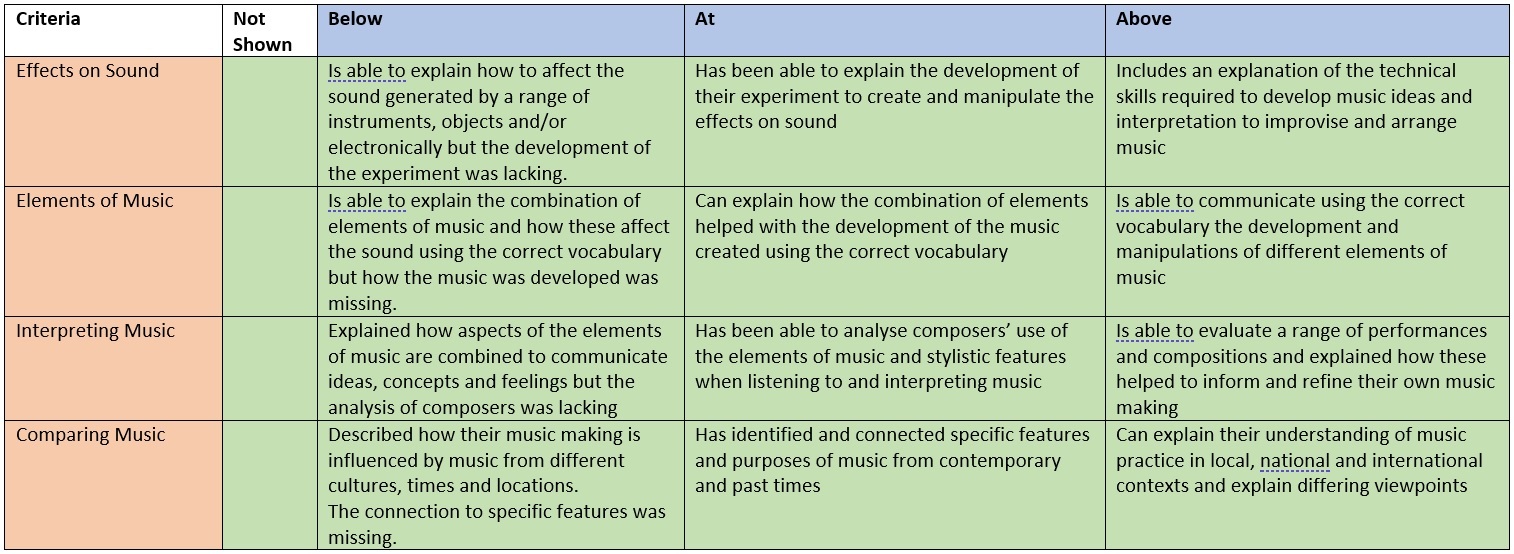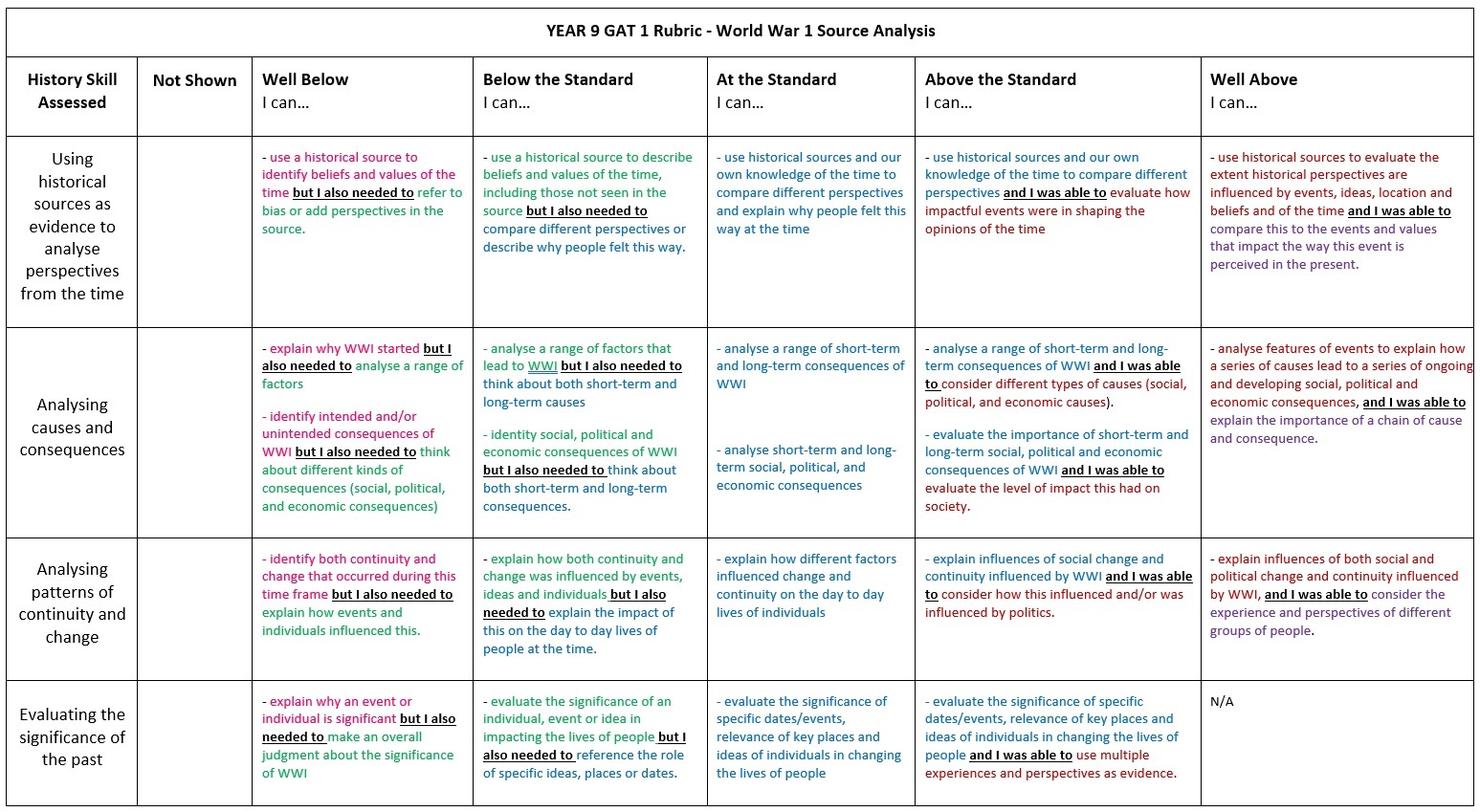The rubric is there to not only assist teachers with making consistent judgements on students’ ability to demonstrate skills and knowledge, but also as a learning tool for students to see what the next levels of progress look like.
So, where do these skills and knowledge come from? At Dromana Secondary College (on Melbourne’s Mornington Peninsula) we are asked to assess our students against the Victorian Curriculum and the Victorian Certificate of Education Study Designs.
Constructing rubrics based on the sometimes-subjective language of curriculum documents can be difficult for most teachers. At Dromana College we had an issue with only a few teachers having the confidence to write a decent rubric and, as a result, these teachers felt as though they were doing most of the heavy lifting.
Guidelines for our teachers
As a school, we therefore came up with our own guidelines on how to construct rubrics for years 7-10. When constructing these guides our aim was to ensure that the rubrics were designed for 3 things.
1. Consistent judgements
It is important that most students in a particular year level and subject are exposed to the same skills and have the same opportunities. Just as important, is the consistency in the way different teachers assess students’ work and make judgements on whether students have demonstrated certain skills or not, and to what level. This is where a well written rubric comes into play. It is important that there is a collaborative approach towards the development of these rubrics and that direct language, rather than subjective language, is used – this ensures teachers have a common understanding of this language and consistent approach towards assessing students’ work.
I don’t want to underplay the importance of moderation and its place in making consistent judgements as this is an essential part of assessment but having a meeting to agonise over subjective language after the fact, compared to discussing a few of the students’ work that teachers are unsure of due to not directly aligning with the rubric, is very different when it comes to using time efficiently.
2. Student Understanding
A well written rubric should also interpret the curriculum in a way that students will understand, so that the interpretation of the learning sequence is the same between teacher and student. This is an essential tool that students can refer to when completing their assessment task as it tells them what knowledge and skills the teacher is looking for at each level of achievement.
Exemplars of work for students to refer to could also be used to help interpret the rubric and to clarify what is required for the task at different levels of achievement. When introducing the task and setting sessional learning intentions, teachers should also go through the rubric to ensure that all students are clear and can interpret the language used. This also allows students to monitor and assess their own progress.
3. Student Feedback
The Australian Institute of Teaching and School Leadership (2012) summarises the benefits of feedback and the fact that this should inform students on: Where am I going? How am I going? Where to next? Isn’t this what a well written rubric should also provide?
A 2-step process
We started with a basic construction (Step 1) where Domain Coordinators were given professional development on the construction of the rubrics. They then took this information to domain meetings to upskill all staff on the process. A more sophisticated version (Step 2) was introduced 12 months later; again, where Domain Coordinators were given PD, so they were on board with the direction of the construction, but this time an action group of leading teachers were firstly given PD on the process and then each leader was given domains to visit a meeting for the introduction of this. Domain Coordinators were then given the role of further implementation of the rubric construction with the support of the action group.
For the basic version, depending on how the curriculum is structured some assessments could include Well below, Below, At, Above, and Well above, while some may only include Below, At, and Above. These levels are listed across the top, started at the lowest and moving to the highest. An overview of the skills that students need to demonstrate should be listed down the left-hand side. Each section on the rubric relating to the skill and level should include a description as to what is required to achieve this (note: numbers, or ‘high’ ‘medium’ ‘low’ should not be used). The skills and descriptions are created from the Victorian Curriculum or, in some cases, a version of skills derived from VCE outcomes. In our own guidelines we noted that:
- It is ideal that all sections include an explanation of what is required, but sometimes there is no translation of the skill in the lower or higher levels
- Each skill should have higher expectations as the explanations move from left to right
- Sometimes it is better to create the rubric BEFORE you actually write the assessment task
With all this in mind, here is an example of the Victorian Curriculum Music year 7 and 8 levels translated into a basic Dromana College rubric.


The development of curriculum is a constant cycle as we continually revisit and refine the way that we monitor and record student learning. Once the rubrics were embedded into this curriculum development at Dromana College, it was important to revisit, revise and refine the documents.
In our refined construction, the levels in all rubrics should be extended to include Well below and Well above. Each section on the rubric relating to the skill and level should include a description as to what is required to achieve this (note: numbers, or ‘high’ ‘medium’ ‘low’ should not be used). The skills and descriptions are created from the Victorian Curriculum or, in some cases, a version of skills derived from VCE outcomes. ‘I can…’ statements are a good way of writing these descriptions, but not a necessity.
We colour-coded the examples to make it easier to explain the different sections and requirements to our teachers. If we look at the Dromana College example below of a Year 9 GAT 1 Rubric:
- Comments in BLUE have come from the Victorian Curriculum for Year 9 (At the Standard). Note that the ‘Below the Standard’ section tells students that these were the skills that were missing or not developed enough, which is why they did not achieve ‘At the Standard’. Also note, the ‘At the Standard’ comments are repeated in the ‘Above Standard’ section (sometimes this may be a slightly summarised version)
- Comments in RED have come from the Victorian Curriculum for Year 10 (Above the Standard). Note that the ‘Above the Standard’ section tells students that these were the skills that they were also able to achieve, which is why they received ‘Above the Standard’. Also note, the ‘Above the Standard’ comments are also repeated in the ‘Well Above’ standard section (sometimes this may be a slightly summarised version). For those domains where the year 7/8 or year 9/10 curriculum is combined, the lower level is written using a basic version of the Victorian Curriculum description and the higher level comes from the whole description of skills necessary to achieve that level
- Comments in GREEN have come from the Victorian Curriculum for Year 8 (Below the Standard). Note that the ‘Well Below’ the standard section tells students that these were the skills that were missing, which is why they did not achieve below the standard.
- ‘Well Below’ standard comments (in PINK) have been written using the Year 7 Victorian Curriculum standards and ‘Well Above’ standard comments (in PURPLE) have been written using VCE outcomes.

The Dromana College rubric clearly covers the consistent judgements, student understanding and student feedback – especially the importance of Where am I going? How am I going? and Where to next? I still see the role of a student-teacher conference to explain the feedback regarding their skills and how to improve, but we believe this initial rubric makes this conference an easier and quicker process.
The use of Blooms Taxonomy is a very important tool in the construction and language used when writing rubrics, and the Victorian Curriculum already has these vital indicators throughout. Our aim is to move educators away from the use of language such as: Rarely, Sometimes, Consistently, Always. This language is very subjective and makes it difficult for teachers to make consistent judgements and for students to understand the feedback. For example, how often is sometimes?
Another issue can be the number of times something is shown by the student. For example, only one argument was given, 2 or 3 arguments were given, or 4 or 5 arguments were given. Whether a student can repeat the same skill several times or not does not indicate that they have progressed to a higher level of the continuum. The progress comes from showing a higher level of skill development, the way in which these arguments are constructed, and the language used – not how many times it was produced.
Some final thoughts
Rubrics are not an easy tool to develop and the more educators we have with the confidence and skills to have a go at these the better. Our rubric construction model at Dromana College may not be a good fit for other schools or educators – some may only take parts of our approach, or just use it to spark conversation on how to improve practice at their own school.
I am not saying that ours is a perfect model, but I am hoping that it brings up some things to think about for you and your colleagues when making judgements on student progress and ultimately improves the understanding between teachers and from teacher to student.
References
Australian Institute for Teaching and School Leadership. (2012). Spotlight: Reframing feedback to improve teaching and learning. Downloaded via https://www.aitsl.edu.au/tools-resources/resource/spotlight-reframing-feedback-to-improve-teaching-and-learning
How are you and colleagues using assessment rubrics in your own school? Are there any areas for improvement in either the design or the use of the rubric, to better support both teachers and students?



